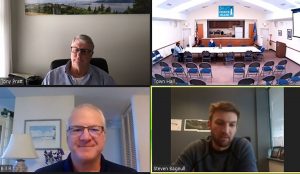
FENWICK ISLAND – Members of a Fenwick Island committee say they will continue to explore deposit sites for the town’s dredging project.
On Wednesday, members of the Fenwick Island Dredging Committee met with Anchor QEA’s Steve Bagnull and consultant Tony Pratt to discuss opportunities for a long-awaited dredging project of the Little Assawoman Bay.
Simply put, the dredging project is expected to address shoaling in the back-bay system and connect boating channels along Fenwick’s bayside canals to the main channel in the Little Assawoman Bay. As part of that effort, roughly 19,000 cubic feet of dredged material would be moved to another site for reuse, though it remains to be seen what that location would be.
In December, committee members began exploring a partnership with Seatowne, a residential community north of Fenwick. The proposed beneficial use project would use Fenwick’s dredged material to replenish roughly 19 acres of wetlands near the community.
On the agenda for discussion this week, Councilman Bill Rymer, committee chair, told members that Seatowne’s homeowners association continues to explore the proposed partnership.
“I got an email back from their president saying the group is excited and interested and for us to keep moving forward, but they did have questions about the project …,” he explained. “Their biggest thing is they need to learn more about what it would look like and feel like on their end of the project.”
While he highlighted Fenwick’s plans to begin the dredging project early next year, Rymer said it was unlikely the town would receive any agreement from Seatowne in time to apply for permitting.
“Their first opportunity for a community-wide vote is May 27,” he said. “That, of course, will change our timeline.”
To that end, committee members this week agreed to focus on action items the town could pursue as it waited on Seatowne’s decision.
“I’m not comfortable releasing any funds for Seatowne consulting work until I get an official green light from the community,” Rymer said.
During Wednesday’s meeting, the committee voted unanimously to recommend a Phase 1B study of the bay’s south channel. Last month, the committee learned an archeological study had identified an underwater object in the proposed dredge area.
“We’ve got this metallic object at the bottom of one of our channels,” Rymer said. “We have a proposal for $10,000 to send professionals in to figure out what it is and if we could deal with it right away.”
Committee member George Murphy said he supported the proposal.
“The $10,000 will get us an answer to what this thing truly is and how hard it would be to remove,” he added.
Bagnull agreed.
“With what we’re proposing, it would be a probe and diver-based effort to identify what it is,” he explained. “Our hope is it’s nothing of significance.”
This committee this week also agreed to explore alternative sites for its dredged material, should the proposed partnership with Seatowne not come to fruition. Murphy suggested the town explore the restoration of Seal Island, located in the middle of the Little Assawoman Bay.
“One, I think it’s incumbent on us to do a cost-benefit analysis so it shows we didn’t overlook Seal Island …,” he said. “Two, I think there’s a large sentiment in the community that we do that, at least look at what it would take to reconstitute Seal Island. The final thing I would like to understand is if reconstituting Seal Island would provide any resiliency.”
Bagnull noted his company had applied for grant funding in 2020 to do preliminary design work for permits to restore Seal Island. While he noted the project supported the state’s restoration and resiliency initiatives, it was a costly endeavor.
“In the grant proposal we talked through how we envisioned the project …,” he said. “The crux is really the containment and the cost.”
Officials noted, however, it was a project worth considering. To that end, the committee agreed to create a subcommittee of sorts to investigate Seal Island as a potential deposit site.
“We need to take a closer look at that and see what volume is needed to restore it to its target elevation,” Bagnull added.
Pratt also told committee members that he and Bagnull would work together to explore other alternative sites in the coming weeks.
“It’s an open book,” he said. “We can brainstorm anything. We’d like a chance to come back with some concepts.”
Plans for a dredging project in the Little Assawoman Bay began in earnest in 2018, when the town council hired Pratt, former administrator for the Delaware Department of Natural Resources and Environmental Control (DNREC), to guide them through the funding and permitting processes. By the following year, Anchor QEA, a Lewes-based engineering firm, was brought on board to provide design, bidding and construction management services.
The original plan for the project was to work with the Carl M. Freeman Companies to relocate the town’s dredged material to one of the developer’s nearby properties. Those proposals, however, were taken off the table late last year when the county’s denial of a hotel project on the site forced the developer to reevaluate its project, as well as its partnership with Fenwick Island.

